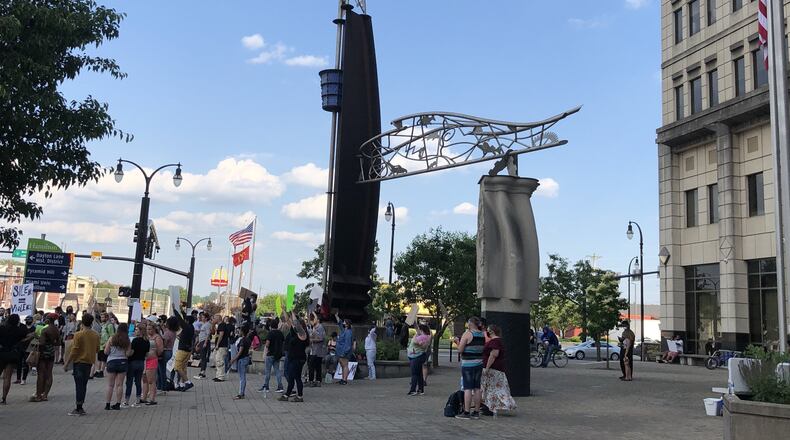Behind most of the crowd, and in front of the government towers of Hamilton and Butler County, stood a tall sculpture known as “The Hamilton Gateway,” which was dedicated Aug. 16, 2000, the year Hamilton was named a “City of Sculpture.”
The sculpture, which is the largest maintained by the non-profit City of Sculpture organization, was donated by Judge John R. and Shirley K. Moser, and represents the city’s hopes for democracy, as well as the Great Miami River and Hamilton’s industrial history.
Created by artists Stanton Sears and Andrea Mylkebust, it is made of Canadian granite, Indiana limestone, stainless steel, steel that was intended to weather over time, a cast glass lantern and a bronze finial atop the artwork.
The artwork represents several things. Here they are:
- The large opening people can walk through represents an "open doorway" that represents democracy. And according to a plaque attached to the sculpture, the blue lantern "is a beacon symbolic of the vital qualities of a democracy: vigilance, truth-seeking and justice."
- Remarkably, the black polished Canadian granite that rises about six feet from the plaza level represents the depth of the Great Miami River flood of 1913, meaning the intersection of High and MLK Boulevard would have been that far beneath the river's overflowing water.
“The entirety of downtown, where we have all these businesses and different events was all under water,” said Taylor Stone-Welch, of the City of Sculpture organization. “I really can’t imagine that amount of water in Hamilton. I’m very glad we don’t have to deal with that in the current state of things.”
If not for work by the Miami Conservancy District in the past century to build flood levees and manage storm water upstream, there might still be occasional floods of the river. RELATED: Hamilton unveils riverfront plan
- The light-colored limestone above the black granite is carved as a rippling water surface, representing "the lasting importance of the Great Miami River in the life of the town, and is symbolic of the enduring yet fluid and adaptable nature of democracy," according to a city pamphlet created after the dedication.
- The stainless steel top of the open door represents various bridges that have crossed the river at High and Main streets. Swirling lines represents currents and eddies of the river that helped industry here grow, with the hydroelectric plant along the river, and steel shapes also echo forms of native fish species.
- The weathering steel of the tallest tower takes the shape of a curved shape, as it it were made of paper, representing the importance to Hamilton of its former paper mills, as well as "other heavy metal industries in the 'rust' belt," the pamphlet about the sculpture states.
- The cobalt-blue glass beacon near the top of the tower has 24 hand-cast lenses with 3-dimensional patterns taken from water forms and sunbursts. The light is intended to make "a symbolic statement about the nature of democracy," and also to serve "as a pleasing element to enliven the work at night," the city's pamphlet states.
- Steel designs near above the weathering steel were taken from 19th century engineering drawings of gears, waterwheels and machine element, again representing local industry.
- Topping the sculpture is the bronze finial, like ones that can be found on various area buildings.
Including sculptures at the Pyramid Hill Sculpture Park and Museum, which technically is outside city limits, Hamilton counts nearly 60 sculptures in the citywide public collection.
In August, art lovers plan to celebrate 20 years since then-Gov. Bob Taft named Hamilton a City of Sculpture. They will do so with the dedication of a new steel sculpture at the intersection of Eaton and Millville avenues at Main Street.
About the Author
